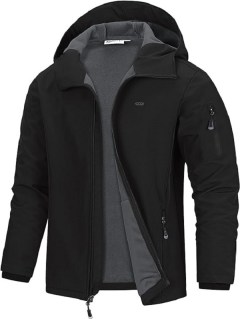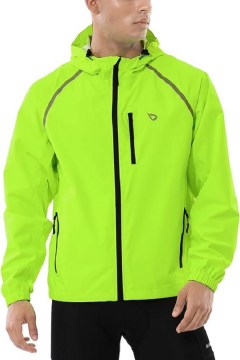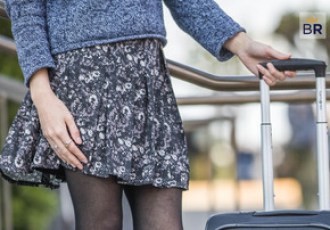
This jacket is heavy-duty, warm, and waterproof, making it a smart option for colder and wetter weather.
This jacket is heavy-duty, warm, and waterproof, making it a smart option for colder and wetter weather.
Soft fleece lining keeps you warm, while the waterproof exterior coating keeps you dry. Offers multiple pockets for storage. Gets top marks for the earphone line fastening and supporting fixture inside the jacket.
Some issues with zippers breaking or sticking.

A packable waterproof jacket that's lightweight, protective, stylish, and affordable.
A packable waterproof jacket that's lightweight, protective, stylish, and affordable.
This packable jacket includes a handy carrying pouch. The lightweight material is both waterproof and windproof. The hooded structure makes it ideal for spending time in the rain. Fits true-to-size for most wearers.
The fabric has a plastic feel that may not appeal to everyone.

A lined jacket with a non-irritating upright collar and 2 forms of closure for easy access despite what the weather calls for.
A lined jacket with a non-irritating upright collar and 2 forms of closure for easy access despite what the weather calls for.
Waterproof jacket with a polyester lining. Features an upright collar with chin guard, 2 side pockets with zippers, and adjustable cuffs and waistband. Has a hood with drawstrings and a full zipper with hook-and-loop closures.
Some users noted that the waterproofing isn't ideal for heavy rainfall.

Check out this waterproof jacket if you need one that's lined but still lightweight enough for mild conditions.
Check out this waterproof jacket if you need one that's lined but still lightweight enough for mild conditions.
Keeps you dry in the rain and is windproof. Sports a hooded design and is insulated with a light fleece lining for adding warmth on chilly days. Packable. Has 5 roomy pockets for stashing items on the go.
Sizes run on the small side, and the sleeves may fit too tight for some.

This is a lightweight jacket that's waterproof, windproof, and highly visible.
This is a lightweight jacket that's waterproof, windproof, and highly visible.
A lightweight jacket that's perfect for rain and warmer weather. Comes in bright colors with reflective stripes. Packable and hooded. Windproof. Flexible fit is perfect for walking, running, golfing, and more.
The material is too thin for cold conditions. Sizes tend to run small.

We recommend these products based on an intensive research process that's designed to cut through the noise and find the top products in this space. Guided by experts, we spend hours looking into the factors that matter, to bring you these selections.

Whether you need a jacket for hiking in light rain or commuting in a downpour, a waterproof jacket can save you the discomfort of soggy clothes. Like all outdoor jackets, waterproof ones vary in their materials, breathability, and insulation.
Most waterproof jackets fall into the category of hardshell jackets, meaning that they are fully waterproof and have a somewhat stiff outer layer. Softshell jackets are designed to be worn over other insulating clothing or even as an additional layer under a hardshell jacket. Some waterproof jackets include additional insulated layers. The degree of waterproofing doesn’t vary much from one jacket to the next, but other factors like breathability and packability can.
A good waterproof jacket can be a modest investment, so it’s important to find the right one for you and your activities. Our buying guide explains the varieties of waterproof jackets available and their common features. We’ve also selected several that we think stand out from the rest.

Choosing a waterproof jacket means considering how much mobility you need and where you’ll wear it and for how long. Though the effectiveness of the waterproofing doesn’t vary much from one jacket or brand to the next, the breathability of jackets does vary considerably. It may seem counterintuitive that when you’re wearing something designed to not let moisture in, you also need a jacket that allows water vapor to escape so you don’t get sweaty.
This isn’t likely an aspect you should worry too much about. Any waterproof jacket will keep the water out. However, there are varying levels of waterproofing measured according to industry standards.
Fabrics are tested by placing a tube of water against the material, flipping the tube so its mouth is pointing downward, and measuring the volume at which water begins to permeate the fabric. A rating of 5,000 millimeters indicates the minimum waterproof rating, but some jackets may be rated for up to 20,000 millimeters. These jackets, of course, come with a higher price tag, but if you expect to be out in downpours for long periods, you won’t regret shelling out a bit extra to stay dry.
Waterproof jackets are constructed of either 2, 2.5, or 3 layers.
2-layers: These jackets have an outer layer of fabric attached to a membrane. There is also an inner liner that isn’t attached to the outer layer — you can pinch both fabrics and pull them apart. This space between layers can provide extra insulation and aid breathability. These mid-priced jackets are well suited to casual wear.
2.5-layers: The name may seem like a misnomer since to the untrained eye there’s only one layer. In reality, there are three layers sandwiched together: an outer fabric, a waterproof coating, and a protective inside layer. These jackets tend to be lightweight and low priced, but they aren’t as durable as other options.
3-layers: These jackets are the most expensive and rugged. An outer fabric liner holds a waterproof membrane snugly in place with the inner liner. These jackets are the best option for hiking and other outdoor activities.
The second most important quality in a waterproof jacket is breathability. If a jacket is prone to trapping moisture, you’re soon going to become sweaty, uncomfortable, and possibly cold. Despite the supposed impermeability of the waterproof layers, it’s possible to allow air to pass through the fabric via microscopic holes. While there is no industry standard for breathability, some companies measure it by testing how many grams of water vapor can permeate a square meter of the fabric in 24 hours. The highest rating is around 20,000 grams.

As with most outdoor wear, waterproof jackets vary greatly in design and additional features.
A waterproof jacket should fit somewhat loosely, allowing you to add layers underneath if necessary. At the same time, it should be snug enough around the cuffs and hem that water can’t get in when the rain is really coming down. Many waterproof jackets are adjustable and have cinch cords in key places so you can keep out water and cold air.
Like the design, the materials in waterproof jackets can vary greatly, and the variety can be intimidating. Nylon, polyester, and polyurethane are the most common materials for fabrics and laminates. The number of synthetic fabrics and laminates is seemingly limitless, so it isn’t worthwhile to get into the specifics of each material here. What’s more important is the distinction between laminates and coatings. Laminates are generally more expensive due to their superior waterproofing and durability. Coatings are lighter and less expensive.
Hood: A detachable or easily adjustable hood allows you to quickly adapt to weather conditions. It’s rare to find a waterproof jacket without a hood because covering your head can prevent water from getting inside your jacket.
Vents: In addition to using highly breathable materials, some waterproof jackets have vents as an extra measure. Sometimes called “pit zips,” these are under the arms and provide an easy way to ventilate the jacket.
Packable design: Some waterproof jackets are packable, meaning they can be folded down into a very small size and stuffed in a backpack or purse. You probably won’t want to wear your waterproof jacket all the time, in which case a packable design is very convenient.
Most waterproof jackets that cost $20 to $60 feature a shell with no insulation and are designed for light rain. The light weight makes them easy to carry and pack away when not in use. While these jackets may not be the most durable, they get the job done and can be easily worn over other layers.
If you spend $60 to $100, you’ll find jackets that have 2 or 2.5 layers. These may be only a shell, or they may have a small amount of insulation. Jackets in this range are designed for daily wear or light hikes.
High-end waterproof jackets that cost $100 to $300 are usually 3-layer jackets with excellent waterproofing and breathability. Their durability makes them perfect for activities like hiking, mountain biking, or skiing.

Choosing what you wear under your waterproof jacket can be just as important as the jacket itself.

A. It means that your jacket probably needs to be cleaned. Oil and other substances in the fabric are retaining water that would otherwise bounce off. You should also reapply a coating of durable water repellent (DWR).
A. Many waterproof jackets are machine washable, but you might need to use a special detergent designed specifically to avoid damaging waterproof materials.
A. All you need to do is hang it up or lay it flat, in direct sunlight if possible to accelerate drying. As with any clothing product, you should check the manufacturer’s recommendations. Whatever method it suggests for drying your jacket after cleaning should work after a storm as well.
Get emails you’ll love.
Learn about the products you’re wondering if you should buy and get advice on using your latest purchases.
